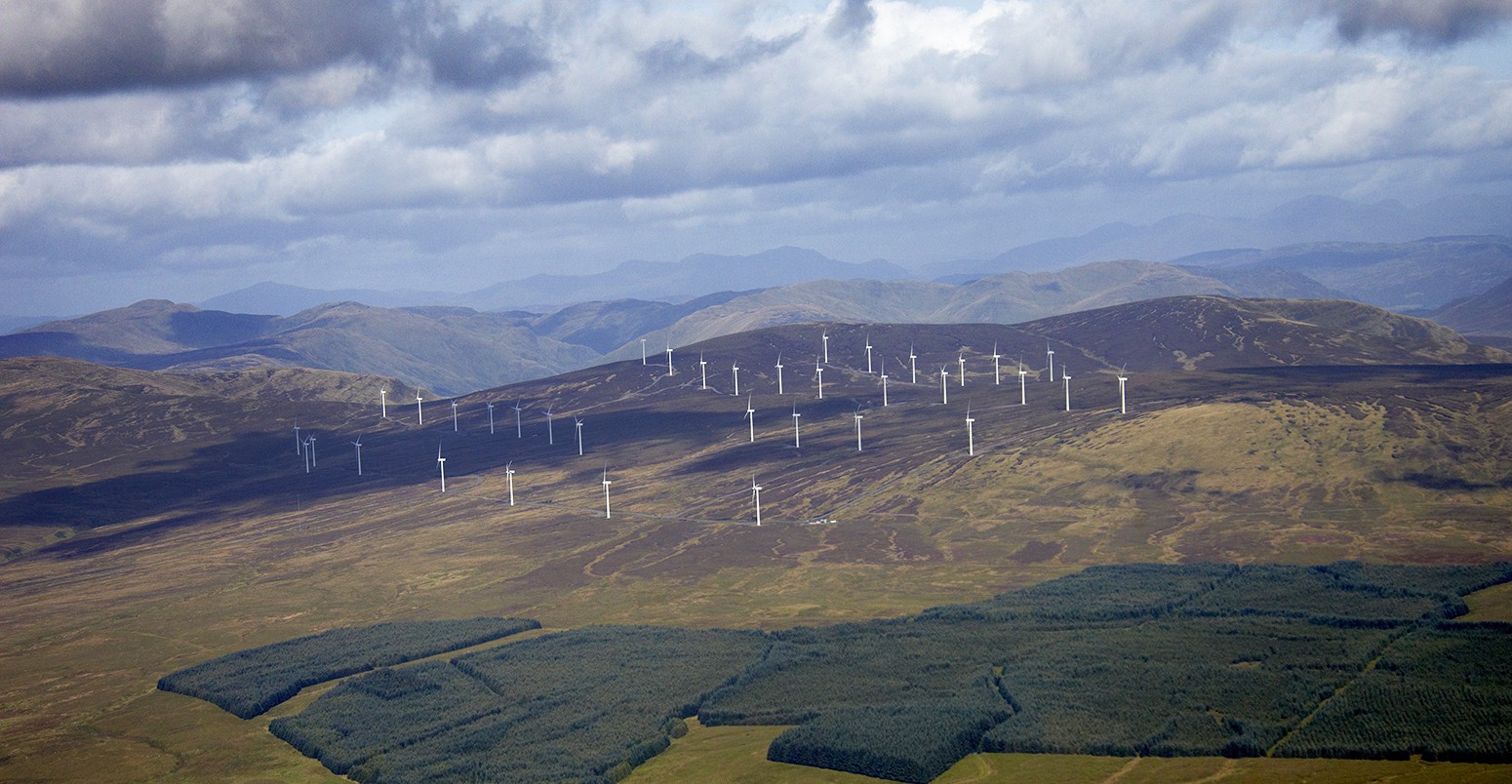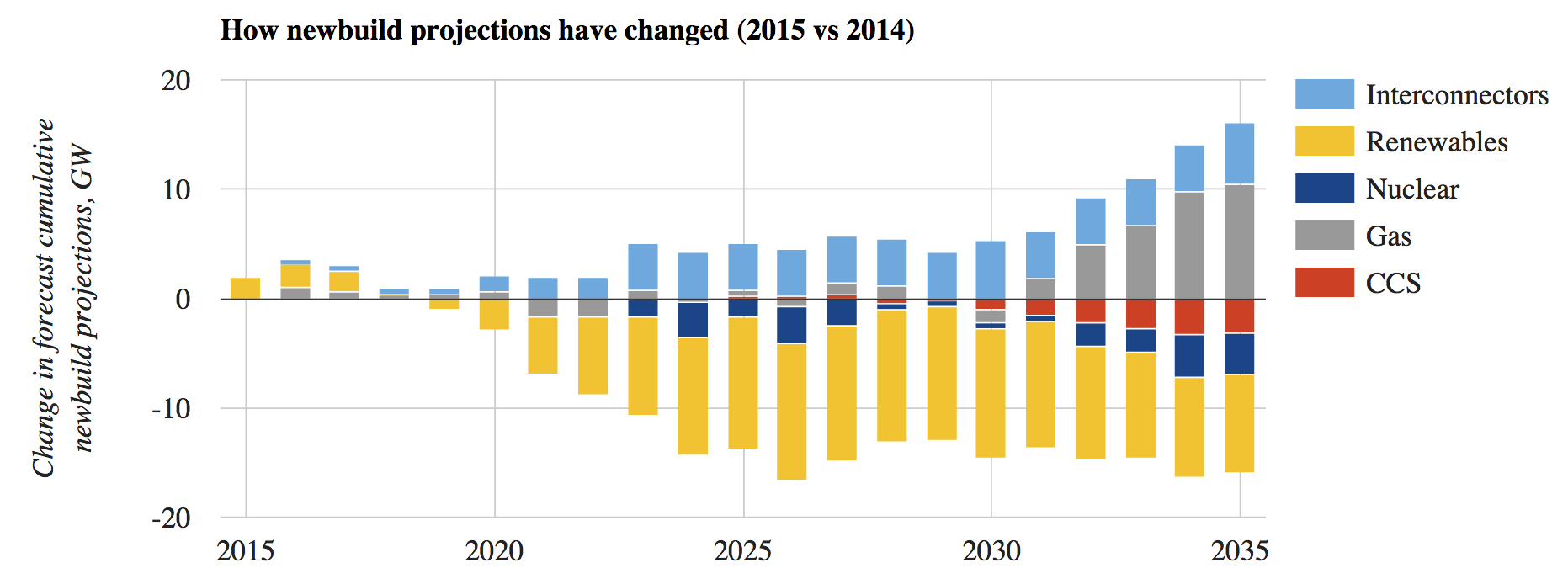
Analysis: UK government quietly slashes renewable energy forecast
Simon Evans
11.24.15Simon Evans
24.11.2015 | 5:01pmThe UK Department of Energy and Climate Change (DECC) has slashed its forecasts for new renewable power capacity by more than a third over the next decade, Carbon Brief analysis shows.
The updated forecasts lay bare the consequences of policy changes introduced by secretary of state Amber Rudd since the May general election. They were published last week in an obscure annex on DECC’s website, on the same day as Rudd was giving her “reset speech” on a new direction for UK energy policy.
DECC has also raised its forecasts for new-build gas and interconnector capacity, our analysis shows, while scaling back expectations for new nuclear and carbon capture and storage (CCS).
The forecasts suggest it will now be harder for the UK to meet its legally-binding carbon budget for 2028-32, due to be unveiled later this week.
Winds of change
Each year, DECC publishes a series of energy and emissions projections setting out its expectations for fossil fuel prices, economic growth, power generation and other key indicators.
Energy-related forecasting is fraught with challenges. Still, the results show how DECC expects things to evolve. Differences between the latest forecasts and those made a year ago under the Coalition government reflect a range of factors: changes in policy, along with shifts in underlying cost and price assumptions.
The table below shows the difference between this year’s forecasts for cumulative new-build power capacity, and those made a year ago. Negative numbers show DECC now expects less capacity to be built than it did in 2014. Positive numbers show it has raised its expectations.

Cumulative difference between the 2015 forecast for new-build power capacity in gigawatts (GW), and the 2014 figures. Negative numbers (red) show that this year’s forecast is lower than last year. Positive numbers (green) show the forecast is now higher. Source: Carbon Brief analysis of DECC energy and emissions projections.
The table shows how DECC has downgraded its expectations for each of the main low-carbon sources of electricity in this year’s projections. For nuclear, this reflects the latest delay to the completion of the planned Hinkley C plant in Somerset, which will not now be ready before 2025.
For CCS, it reflects the slow progress being made with two pilot plants, the White Rose and Peterhead schemes. However, the reductions are particularly striking for renewables.
Last year, DECC said 34 gigawatts (GW) of new renewable capacity would be built by 2025. Now, it has reduced this figure to 22GW, more than a third lower, as the second table below shows.

Percentage difference between the 2015 forecast for cumulative new-build power capacity in gigawatts (GW), and the 2014 figures. Negative numbers (red) show that this year’s forecast is lower than last year. Positive numbers (green) show the forecast is now higher. Source: Carbon Brief analysis of DECC energy and emissions projections.
Richard Nourse, managing partner at Greencoat Capital, tells Carbon Brief that DECC’s new forecasts see just 10GW of new renewables being added in total during the 2020s.
Last week, Rudd said the government would support up to 10GW of offshore wind during the decade. Her department’s forecast would therefore leave no room for other renewables to be built — whether onshore wind, solar, tidal, biomass or other.
In total, DECC’s latest forecasts see 27GW of renewables being added to 2030. For comparison, the Committee on Climate Change suggests at least 40GW must be added in order to stay on track for the UK’s carbon budgets.
Dash for gas
In contrast to low-carbon sources of power, DECC is now forecasting higher deployment of new gas-fired generation capacity, particularly in the 2030s. It expects 27GW of new-build gas by 2035, up from 16GW in last year’s figures.
The shift appears to reflect Rudd’s pro-gas rhetoric. This has sparked fears of a new dash for gas, which could lock the UK into continued fossil fuel use in the 2030s, when gas-fired electricity is supposed to be on the way out.
DECC’s forecasts show the UK generating up to 70% more gas-fired electricity in the early 2030s than was expected last year, Carbon Brief analysis shows. The department’s forecasts also show the UK to be further away from its carbon targets than thought a year ago.
The other major change compared to last year’s forecasts is a doubling of expected new-build interconnector capacity. DECC clearly has brighter expectations for new undersea cables, reflecting plans in the works for links to Norway, Belgium, and France.
The changes in DECC’s forecasts for new-build power capacity are summarised in the chart below. As with the tables, negative bars show DECC has downgraded this year’s forecast compared to the 2014 number while positive bars reflect raised expectations.

Change in forecast cumulative new-build capacity projections, in gigawatts, between 2015 and 2014. Negative numbers show this year’s forecast is lower than last year. Source: Carbon Brief analysis of DECC energy and emissions projections.
Conclusion
Policy changes introduced since May are likely to increase UK emissions, according to BBC analysis published earlier this month. Carbon Brief’s analysis of DECC’s projections illustrates the department’s own understanding of how its policies have altered the UK’s energy path.
Carbon Brief asked DECC to comment on our analysis, but had not received a response at the time of publication.
On Thursday, the Committee on Climate Change will recommend a legally-binding carbon budget for 2028-32, a target which is likely to be harder to reach in light of DECC’s significantly reduced expectations for low-carbon sources of electricity in that period.
The UK could still meet its carbon budgets. But the growing gap between the targets and projected emissions must be closed with new policies, if the UK is to stay on track. Last week, Rudd said she would set out her plans to meet the fourth and fifth carbon budgets in the second half of 2016.
Update 25/11/15 – We added further details on forecast renewables additions during the 2020s.
Main image: Uamh Beagh and Braes of Doune wind farm, Scotland. Credit: © 145/Andrew Holt/Ocean/Corbis.
-
Analysis: UK government quietly slashes renewable energy forecast
-
DECC has slashed its forecasts for new renewable power capacity by more than a third over the next decade - Carbon Brief analysis
-

